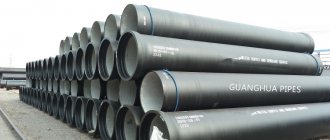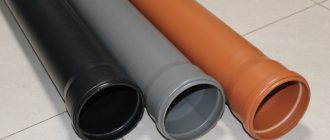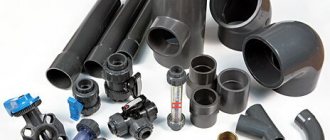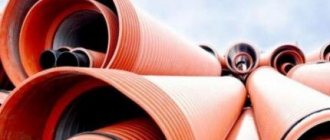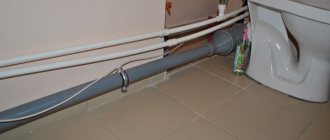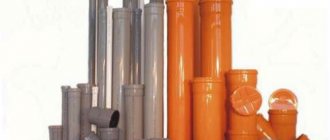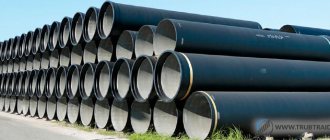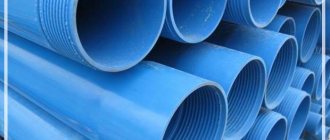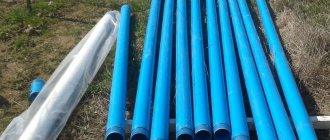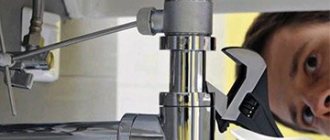Let's look at cast iron pipes for sewerage: dimensions, diameter and classification. As well as technical characteristics, advantages and disadvantages of these pipes in the apartment. First things first.
Modern sewer systems are usually assembled from PVC or propylene pipes. However, the widespread transition to plastic has not been able to completely eliminate cast iron sewer pipes from use, the dimensions of which are somewhat different from more modern varieties. The performance qualities of traditional varieties are noticeably ahead of new models, therefore, despite some disadvantages, they are still actively used for assembling critical sewer lines. Let's take a closer look at them.
Assembly method
In practice, you often encounter two types of connections:
- pipes of the same type, that is, cast iron;
- assembly plastic-cast iron.
Let's look at each of them in detail.
How the connection is made.
The use of socket pipes makes installation more convenient, so let’s look at how they are joined.
The algorithm of actions is performed in the following order:
- The ends of the pipes to be connected are cleaned, after which lubricant is applied to the socket and the smooth end, and then they are joined. It should be noted that the socket must be on the pipe to which the connection is made. That is, to an already installed one;
- Next, chasing is carried out; for this, a tarred sealant (for example, tow) is inserted into the gap between the socket with the flat end of cast iron sewer pipes. They need to fill the bell about two-thirds full. The tool used is a wooden spatula and a hammer;
- to fill the remaining space in the socket, a non-impregnated sealant is used, this improves the quality of adhesion to cement;
- Cement mortar is prepared, we recommend using grades 300 or 400 in a proportion of 1/9 to water;
- the prepared solution is poured into the socket, after which it is compacted.
Implementation of a socket connection
When joining, it is very important that the connection is completely sealed. For this purpose, when installing sewer pipes made of cast iron, the cement solution is replaced with a sealant
This option is more reliable, but much more expensive.
How to connect a cast iron sewer pipe to a plastic one.
This type of docking is much simpler. To connect cast iron and plastic pipes of the sewer system, you will need to buy a connecting collar and sealant.
Connecting cuff
The process occurs in the following order:
- it is necessary to clean the inner surface of the bell;
- sealant is applied to the cleaned area;
- The cuff is installed, a plastic pipe is connected to it, after which the connection takes the form shown in the figure.
Connecting a plastic outlet to a cast iron riser
Choosing the right diameter
When selecting materials for arranging a wastewater disposal system, you should remember not only what diameter the sewer pipes are, but also take into account some of the nuances of such work:
- The cross-section of a horizontal pipeline cannot be larger than the diameter of the sewer riser pipe into which waste water is discharged. In addition, you need to remember that any narrowing in the structure located in the direction of movement of the drains are places where blockages will form.
- Horizontal connections must be mounted from angles and oblique tees. Angles of 90 degrees are allowed only when connecting a horizontal section of the system to a sewer riser. If you follow this rule, there will be no problems if you need to clean the sewer.
- It is mandatory to install revisions in the places where the sewer structure turns, which are cleaning holes with covers. An exception is allowed only when there is, for example, a tee nearby that serves to connect a sink. If necessary, it is he who will perform the audit function.
- When risers are located in multi-story buildings, revisions are placed every three floors. It would not be superfluous to arrange an audit in horizontal blind areas with a length of more than 12 meters.
- The sewer riser is left open at the top, which is explained by the need for air suction, otherwise the vacuum when flushing sewage on the lower floors will suck in the water seal from the plumbing fixture installed on the top floor, and the unpleasant smell will quickly spread throughout the entire apartment.
- The slope of a horizontal pipe should be 1-2 centimeters per meter. If you make it larger, the water will not only make more noise when drained, but also silt up. When the slope is less, the drainage drains too slowly.
- When laying a sewer system under a screed, it should be thermally insulated with rolled material and then the sound of water will not be heard much.
- Plastic products with a diameter of 40-300 millimeters can be cut without problems with a hacksaw or grinder. As a result, the cut is smooth and free of burrs. Then you need to chamfer the pipe.
- The sewer structure is fastened at intervals equal to ten pipe diameters.
- When laying plastic pipes with a diameter of 40 to 300 millimeters, they should be left with free space in case of thermal expansion. Therefore, when inserting pipes into the socket of the previous elements, they do not need to be pushed all the way, but should be left about 0.5 centimeters. Then, during prolonged drainage of hot waste, the pipeline sections mounted end-to-end will not be damaged.
- The entire sewer system is assembled so that the sockets are located towards the moving liquid.
Standard
The current standard for gray cast iron water pipes was introduced in 1977; the latest transformations were introduced into the text quite recently, in 2011. So, what should cast iron pipes for water supply be like according to GOST 9583-95?
Dimensions
The standard provides for cast iron water pipes of three classes of wall thickness - LA, A and B.
| Conditional bore, mm | Wall thickness, mm | ||
| LA | A | B | |
| 65 | 6,7 | 7,4 | 8,0 |
| 80 | 7,2 | 7,9 | 8,6 |
| 100 | 7,5 | 8,3 | 9,0 |
| 125 | 7,9 | 8,7 | 9,5 |
| 150 | 8,3 | 9,2 | 10,0 |
| 200 | 9,2 | 10,1 | 11,0 |
| 250 | 10,0 | 11,0 | 12,0 |
| 300 | 10,8 | 11,9 | 13,0 |
| 350 | 11,7 | 12,8 | 14,0 |
| 400 | 12,5 | 13,8 | 15,0 |
| 500 | 14,2 | 15,6 | 17,0 |
| 600 | 15,8 | 17,4 | 19,0 |
| 700 | 17,5 | 19,3 | 21,0 |
| 800 | 19,2 | 21,1 | 23,0 |
| 900 | 20,6 | 22,3 | 25,0 |
| 1000 | 22,5 | 24,8 | 27,0 |
The weight of a linear meter of pipe varies from 11.3 kg (65 mm, class LA) to 627 kg (1000 mm, class B). The standard provides for the production of socket pipes of measured length (2; 3; 4; 5; 6; 7; 8; 9 and 10 meters) and unmeasured lengths from 2 to 10.5 m.
Requirements
The transition of the cylinder into the bell may be made with a slope or in the form of a ledge.
The dimensions of cast iron pipes for water supply may vary from the nominal ones within the following limits:
- The length of the measuring pipe is +-20.
- Wall thickness - -1 + 0.5.
- Outer diameter (up to 300 mm) - +-(4.5+0.0015D).
- Outer diameter (more than 300 mm) - +(4.0+0.0015D) -(5.0+-0.0015D).
- The internal diameter in the socket is +(2.5+0.002 D) -(1.5+0.002D).
Ovality cannot lead the pipe beyond the normalized deviations from the nominal size. The deviation of the actual mass of the pipe from the calculated mass cannot be more than five percent. Pipes undergo hydraulic pressure testing, which is determined by their nominal size and class.
| DU | Test pressure, kgf/cm2 | ||
| Class B | Class A | Aircraft class | |
| 300 or less | 40 | 35 | 25 |
| 300 — 600 | 35 | 30 | 20 |
| More than 600 | 30 | 25 | 20 |
The end of the pipe opposite the socket must be cut perpendicular to its axis with a deviation of no more than 0.5 degrees.
The inside and outside of the product are coated with a protective non-toxic material. Along with this, the coating should not interfere with the sealing of the butt joint, peel off and soften at temperatures up to +60 C.
Specifications
The parameters of all elements of drainage networks are subject to the requirements of GOST and SNiP. They are manufactured with careful adherence to technology, since the condition of the sewer lines determines the comfort and safety of people. Main characteristics:
- connection type;
- appointment;
- size.
The diameters of cast iron sewer pipes are the main indicators that guide design and construction. It must be taken into account that the thickness of their walls is quite large - from 7.4 to 27 mm (depending on the diameter). When designing communication systems, it is customary to take into account different sizes - to calculate the throughput, the internal diameter of a cast-iron sewer pipe is needed, and for installers, the external size is important. According to the wall thickness they are divided into groups:
- A. Medium wall thickness, can be used in most buildings or systems;
- B. They have maximum wall thickness. Can work in high pressure pressure systems;
- LA. The thinnest products. Typically used in gravity flow systems of residential and private houses.
Classification of water pipes
Historically, measurements were calculated in inches. This meaning differed in each state. It was conventionally equated to:
- the width of the index finger;
- the length of three barley grains from the middle of the spikelet;
- the ratio of the distance from the tip of the nose to the thumb of the outstretched hand of King Henry 1 of England.
As a result of the development of civilization and relationships between states, people realized that it was inconvenient to use such a value for full-fledged trade. For this reason, everyone switched to a common measuring system and distances began to be measured in meters. The value of the current meter was fixed in 1983 at the XVII General Conference on Weights and Measures. At this stage it is tied to the speed of light. Despite this, diameters in water pipes continue to be measured in inches. It is officially recognized that this unit is equivalent to 0.0254 meters, or 25.4 mm.
Steel
Steel pipe size chart
Steel pipe size chart
When installed with steel products, their selection is made according to the outer diameter of the water supply system pipe. According to the requirements of GOST 10704–91, they are divided into groups:
- large diameter - from 508 mm;
- medium – 114-530 mm;
- small – up to 114 mm.
In home plumbing, the most popular products are those with small sizes. Medium - in the city water supply. Large - for main oil and gas pipelines. The most popular products include:
- ½” - 12.7 mm;
- ¾” - 19.0 mm;
- 1” - 25.4 mm;
- 1½” - 38.1 mm.
Specialists who are involved in laying and repairing water pipes on a daily basis know these values by heart, while others look them up in tables.
Features of cast iron
Cast iron is a metal made from iron with the addition of carbon. Probably every second person, if you ask him what qualities cast iron has, will be able to say that this material does not rust, has a large mass, is cheaper than steel and is fragile.
Not so long ago, domestic metallurgists invented a new type of cast iron, which is much higher in strength than we used to think. The composition of this metal, in addition to iron and other additives, includes carbon in the form of graphite. Scientists have developed a method in which magnesium particles are added to graphite during subsequent heat treatment. As a result, carbon takes on a spherical shape. And the new type of material was called nodular cast iron.
This means that modern cast iron water pipes have acquired qualitatively new characteristics:
- high strength;
- durability;
- resistance to aggressive substances.
Therefore, pipes made from this material can be used not only for water supply, but also for sewerage.
Modern technologies make it possible to spray zinc onto these products, which improves anti-corrosion properties. Pipes are also produced with different coatings: bitumen and polymers, which significantly increases their service life.
Scope of application of cast iron pipes
Cast iron pipes for water supply are used, as a rule, to supply cold drinking water in large main water pipelines that provide water to a large number of people. Laying is carried out directly in the ground; if necessary, the pipes are insulated. The result is a pipeline that is significantly cheaper in cost than steel pipes.
But such a highway has one significant drawback - an insufficiently reliable connection, which can be broken when soil layers move.
How to correctly convert inches to mm.
Inch is an English unit of measurement equal to 2.54 cm. When marking products, inches are indicated by numbers with quotation marks (1″, 2″, etc.)
For example, in order to calculate the outer diameter of a pipe = 1″, you need to add the wall thickness multiplied by 2 to 2.54 cm.
When carrying out work on installing a water supply system, it is necessary to observe the dimensions as accurately as possible. Otherwise, the water supply joints will not have a sufficient degree of tightness. And the service life of such a system will be significantly reduced as a result of leaks.
Sewer repair
During operation, cast iron pipes may be damaged. Cracks, chips or other defects form on their surface. In this case, repair of the sewer network is required. It is carried out as follows. A rubber gasket is applied to the damage. For the best effect, use 2-3 pieces. The gaskets are pressed with metal hoops.
Repairing a small leak in a pipe is done differently. Initially, it is slightly expanded and degreased. Next, a repair composition is prepared, consisting of copper oxide and phosphoric acid in a ratio of 1.5:1. The crack must be sealed immediately, as the solution hardens very quickly.
Thus, cast iron pipes are a very effective option for sewerage installations. They have excellent performance properties, their service life can exceed 100 years. In case of damage, they are quickly repaired. However, it is worth remembering their fragility and low resistance to impact loads. The heavy weight complicates the installation process.
How to repair
To repair a crack in a cast iron sewer pipe, it must be repaired. For this purpose, you will need to prepare a special mixture; its composition is easy to find on the Internet.
After the mixture is prepared, the edges of the crack are cut and deepened using a scraper. Next is degreasing. At the final stage, the formed depression must be covered with the previously prepared mixture.
You can also restore the tightness using a homemade clamp. To do this, you will need two or three pieces of dense rubber and metal plates for them. The resulting gasket is pressed against the pipe using a hoop equipped with a tightening bolt.
Instead of a hoop, you can use wire, tightening it with pliers, but the reliability of such a clamp will be questionable.
Internal and external diameters of cast iron sewer pipe: assortment
Cast iron pipe products are used in the installation of internal and external (ductless and ducted) pipelines for sewerage. Their service life sometimes reaches one hundred years. The range of cast iron sewer pipes and connecting elements is determined by GOST 6942-98, and quite strictly.
Range of cast iron pipe products
There are only three units of the range, which differ in cross-sectional size. There are two main types: SMU - with smooth ends and SME - one end is smooth, the other with a socket. Pipe products made of cast iron are marked according to their nominal cross-section.
The first part of the inscription is the grade of material, the second part is the nominal cross-section (for example, if the marking indicates DN 100, then the internal diameter of the cast iron sewer pipe is 100 mm, the outer diameter is Ø110 mm). Products with a socket are divided into 3 classes - A, B, LA (depending on the wall thickness).
The weight completely depends on the size, for example, a cast iron sewer pipe DN50 - 11 kg, DN100 - 25 kg, DN150 - 40 kg, DN 1000 - 620 kg. But this is just an estimated mass, which may differ significantly from the real one. Due to their heavy weight, cast iron pipe products are sold in lengths of 0.75-7 m.
When choosing, you should keep in mind that you should not purchase materials with a thick wall if the pressure in the system is low. This will reduce the costs of purchase, transportation and installation.
Advantages of cast iron pipe products
- designed for 80-100 years of operation without losing quality;
- resistance to the formation of a corrosive layer;
- resistance to mechanical damage;
- ability to withstand frost down to -60°C;
- plastic;
- low operating costs (repairs are rarely required);
- easy disposal and recycling;
- environmental Safety;
- wide range of operating temperatures;
- the ability to bury to a depth of 10 meters;
- During installation, you can use welding, socket connections and fittings.
Disadvantages include heavy weight, roughness of the internal surface and the need for special materials for installing sealed connections.
Installation of a cast iron sewer system
For internal sewerage, a cast iron pipe of 50 (du) and 100 (du) is used.
Installation is carried out using fittings
- elbows (socket-shaped, socket-smooth end, flanged);
- bends (socket-shaped, 10°, 15°, 30°, 45°, 60°, socket-smooth end 10°, 15°, 30°, 45°, 60°0;
- double bells;
- nozzles (flange-socket, socket-smooth end, with transition to steel);
- stubs;
- releases;
- tees;
- crosspieces;
- transitions.
To ensure tightness, the use of a sealing gasket is mandatory. When laying vertically (for example, a riser - sewer pipe Ø 110), the pipeline is hung on supports and attached to the wall with brackets and clamps. This installation method is due to the weight of cast iron products, for example, cast iron Ø100 weighs 20.8 kg.
Tubular products from all manufacturers are manufactured to the same dimensions. For example, cast iron pipe 150 is the same in Russia as in Ukraine, so they are completely interchangeable.
But this condition does not apply if the old sewer system is installed from material manufactured before 1974. In this case, adapters are required.
The dimensions of external sewerage are determined by Sanitary Norms and Rules (SNiP)
- intra-block network - diameter of cast iron sewer pipe 150 mm;
- street network – 200 mm;
- street storm network – 250 mm.
External networks are installed mainly using the socket method:
- the smooth end of one segment is placed in the socket of the other;
- the free space is filled with tow and caulked using a special tool and a hammer;
- the tow should fill 2/3 of the volume of the socket;
- the remaining third is filled with cement mortar or silicone sealant.
To properly arrange a sewerage system, it is necessary to correctly calculate the diameter of the cast iron pipe and fittings. Dimensions vary over a fairly wide range, allowing installation of a pipeline of almost any configuration.
Scope of application of VShCHG
After the advent of plastic and other modern materials, when designing a pipeline, it makes sense to consider VShGCh pipes, which are much superior in their performance parameters to other design options. Scope of application of VSHGCH:
- Laying a water pipeline for supplying drinking and industrial water.
- Laying sewers in private construction and industrial facilities.
- On drilling rigs.
- Creation of central lines operating under pressure. Some types of ductile iron can withstand pressures up to 1.8 MPa.
- When laying an oil pipeline. The fact that the surface is not susceptible to the effects of petroleum products and chemicals allows the use of ductile iron in cases of highly aggressive environments.
- In some cases, the pipes in question are used when laying a gas pipeline.
The most durable water pipes belong to class B and are produced taking into account GOST 5525-61. The tests carried out and established standards determine that they can last for more than 100 years. Due to internal and external protection, the surface is subject to less impact; over many years of operation, the basic properties remain unchanged; a breakthrough is possible only if the pressure in the system significantly increases or errors are made during installation work. In addition, do not forget about the low ductility of cast iron: when a liquid freezes, it expands, and the pressure created can disrupt the integrity of the system. Therefore, when laying cast iron pipes, the level of soil freezing is always taken into account or high-quality thermal insulation is carried out.
Standard sizes of sewer pipes and their purpose
Modern industry produces sewerage pipes in accordance with the required technical standards. Indicators vary for each type of room (kitchen, bathroom, toilet), and also depend on the expected load on the system. The last point is determined by the number of family members living in the apartment or house.
The main parameters that it is recommended to pay attention to when choosing sewer materials are the following:
- internal diameter - the main parameter, which is fundamental for the entire sewer network, is designated as “D”;
- nominal diameter – designated “DN”, determines the nominal value of the internal diameter of the pipe;
- nominal diameter - designated “DN”, indicates the total diameter of the entire structure.
In addition, professionals pay attention to the thickness of the pipe wall and its material of manufacture. In addition to technical data, it is worth paying attention to the components - when choosing adapters, you must adhere to exact compliance with the dimensions and purpose of the products
PVC
The tables show values for internal and external plastic sewage systems.
Table No. 1 - internal system:
| DN (mm) | D (mm) | Wall thickness (mm) (minimum value) | Wall thickness (mm) (maximum value) |
| 32 | 30 | 1 | 1.8 |
| 40 | 38 | 1 | 1.8 |
| 50 | 47.4 | 1.3 | 1.8 |
| 75 | 71.2 | 1.9 | 2.3 |
| 90 | 85.6 | 2.2 | 2.8 |
| 110 | 104.6 | 2.7 | 3.4 |
Table No. 2 – external system:
| DN (mm) | D (mm) | Wall thickness (mm) (minimum value) | Wall thickness (mm) (maximum value) |
| 125 | 118.6 | 3.2 | 3.9 |
| 160 | 153.6 | 3.2 | 4.9 |
| 200 | 192.2 | 3.9 | 6.2 |
| 250 | 240.2 | 4.9 | 7.7 |
| 315 | 302.6 | 6.2 | 9.7 |
| 400 | 384.6 | 7.7 | 12.3 |
| 500 | 480.4 | 9.8 | 15.3 |
| 630 | 605.4 | 12.3 | 19.3 |
| 800 | 769.2 | 15.4 | 24.5 |
| 1000 | 960.8 | 19.6 | 30.6 |
| 1200 | 1151 | 24.5 | 36.6 |
The optimal pipe sizes for internal sewerage are considered to be 32-110 mm. For outdoor – 160-500.
Based on the fact that manufacturers produce almost all possible sizes of sewer components, choosing the optimal one for individual housing is not a problem. The most common values, which also comply with the approved SNiP requirements, are considered (data in mm):
- washing machine and dishwasher – 25;
- sink – 30-45;
- bath, kitchen sink – 40-50;
- combined drain (bathroom, bathtub) – 50;
- riser outlet – 70-85;
- central drain - 110-120.
The indicators are typical for internal sewerage. When laying sewerage outside the house, it is recommended to use plastic components of the following diameter (data in mm):
- output to the cleaning system – 160-200;
- removal of water from the bath – 200;
- swimming pool – 230;
- city sewer network - from 300 to 1100.
Types of non-pressure cast iron fittings
Pipes of this type are available in two types:
- containing a bell at one of the ends (bell-shaped), the presence of which is convenient for installation;
Bell-shaped TCs
- socketless, they are practically not used in domestic sewer systems; they are used for external installation.
Pipes that do not have a socket
Note that there are also cast iron pressure pipes, but they are not used in the domestic sewer network.
The dimensions of cast iron pipes used in sewer systems, as well as fittings for them, are standardized by GOST 6942-98.
For laying sewerage in the apartment, pipes with a diameter of 50 and 100 mm are used. In this case, the drainage for almost all plumbing fixtures (with the exception of the toilet) is organized with Ø50 mm pipes. The toilet is connected to a Ø100 mm pipe.
As for the fittings, standard fittings are used for sewerage networks; their image is shown in the figure.
Fittings for sewerage systems
The picture shows:
- A – transition, used to connect pipes of different diameters;
- B – crosspiece, allows you to organize two branches in different directions;
- C – coupling, it is used to connect pipes with the same diameter;
- D – revision, allows you to clean cast iron sewer pipes when they are clogged;
- E – indentation, used when it is necessary to “raise” or “lower” the pipeline;
- F – pipe, used to increase the length;
- G – bend, installed if a turn is required;
- H – tee, used when it is necessary to cut a branch into a cast iron pipe of a sewer network.
The figure does not show a plug; it is used to close an unused outlet.
External sewerage
The external sewer system runs underground on the street and carries wastewater to the septic tank. Pipes for external sewerage can withstand static and dynamic loads:
- soil pressure,
- movement of people
- traffic,
- groundwater movement,
- temperature changes,
- humid environment,
- aggressive environments.
Dynamic loads. These are all variable loads: movement of cars and people, movement of groundwater. Pipes with high ring stiffness can withstand dynamic loads well.
Static loads. These are loads that constantly put pressure on the pipeline: soil pressure. Products with high ring rigidity also resist pressure well. Static loads also include others; we will consider them separately.
Temperature changes. The most dangerous are cold snaps, since many pipes can withstand 30-degree heat, but cannot cope with 30-degree frost.
Wet environments. High humidity in spring and autumn destroys ferrous metals without anti-corrosion coating and some other materials. Groundwater movement can dislodge the pipeline if it is not installed correctly.
Aggressive environments. These are acids, salts and alkalis that are found in soil and wastewater. Therefore, pipes inside and outside must be resistant to various substances.
Properties of socket products
These pipes remain popular today, despite the flooding of the market with new materials. They are used in various industries, and their main advantage is their increased service life, which is especially true when compared with other analogues. This is due to the fact that over time the steel begins to rust. The disadvantage is the fragility of cast iron. The complexity of installation is more complex compared to other pipes. In order to eliminate the effects of corrosion, the products inside and outside are coated with bitumen.
Cast iron pipe sizes
The parameters of cast iron pipes and components are regulated by GOST 6942-98. To lay a sewer system in a summer cottage, structures with non-standard dimensions are used.
Diameter
To calculate it, the nominal (Dn) and outer (G) diameters are used, as well as the nominal diameter (Dy), which determines the internal cross-section of the pipe. The choice of model in this case is influenced by the volume of waste liquid passing through it.
For installation in internal sewerage systems, structures with indicators of 50 and 100 mm are used. The drain is organized using cast iron products measuring 50 mm, and the toilet is connected to a pipe with a diameter of 100 mm.
When the volume of wastewater increases, parameters are selected from the range from 500 to 1200 mm. The installation of the external system is carried out using pipes of 100-150 mm.
Weight and wall size
The large dimensions of cast iron structures cause difficulties when laying sewer networks, but at the same time give them the necessary strength.
The standard defines the ratio of 2 m of pipe and its nominal diameter as follows:
- 50 mm
– 11 kg; - 100 mm
– 25 kg; - 150 mm
– 40 kg.
Taking into account this indicator, cast iron sewer pipes are divided into the following classes:
- A
. The products are installed in the most difficult sections of the pipeline. This material can withstand a pressure of 0.1 MPa even without bitumen coating. - B.
_ The products have the largest wall thickness, thereby increasing the strength of the structures. - LA
. Designed for indoor installation in places where there are no heavy loads. The pipes can withstand hydraulic pressure of no more than 25 kgf/cm².
The high weight of cast iron products adds costs when working with pipes - installation may require the help of a partner.
Installation recommendations
Bell pipes have their own installation technology. They are laid in such a way that the end of the socket is directed against the flow of water flow. The lower part of the pipeline is rigidly fixed to the support pad, and the upper part allows for slightly loosened fasteners, which makes it possible to rotate the pipe in order to finally and correctly determine its location at the support point.
After laying the assembled section of the pipeline, they begin to carefully caulk the sockets, which is the filling of the sinuses at the pipe joints. In addition to tightness, caulking must have some degree of elasticity. Upon completion of this stage, the upper part of the mounted section is rigidly fixed to the support and pipe laying begins on the next section of the water supply network.
Along the entire length of the highway, work is carried out in a similar way. This technology also applies to the installation of shaped products.
No. 2. Cast iron pipes for internal sewerage
Several decades ago there was no particular alternative to cast iron pipes, so they are widely found in old houses. Today, cast iron is being replaced by plastic, but is still used.
Such pipes are made from gray cast iron by centrifugal casting. To protect the material from corrosion and make the internal surface smooth, the pipes outside and inside are coated with a bitumen compound. The diameter of cast iron pipes ranges from 5-15 cm, the wall thickness is 10-12 mm.
Advantages of cast iron pipes:
- durability. The service life reaches 50 years and often exceeds this mark. Some data suggests a longevity of 90-100 years;
- high strength and resistance to deformation. On the other hand, the material does not tolerate shock loads well;
- the ability to withstand long-term exposure to hot waste (from a washing machine or dishwasher, for example);
- resistance to temperature changes;
- fire resistance;
- environmental Safety;
- good sound insulation.
Surely, cast iron pipes would have remained among the leaders if not for significant shortcomings:
- the walls become overgrown with sediment over time. This is all due to the roughness of the material, which even with a bitumen coating cannot be completely eliminated. The process of overgrowing leads to a narrowing of the pipe lumen and a decrease in its throughput. Anyone who has seen what a pipe looks like after many years of use will never forget this terrible sight;
- heavy weight of pipes, which complicates transportation;
- complex installation, which is explained not only by the large weight, but also by the peculiarities of connecting pipe sections. In order for the sewer system to be airtight, it is necessary to correctly connect the elements. Usually they use the method of caulking or caulking using a heel; susceptibility to corrosion processes;
- high price.
Cast iron pipes are not used today to build a new sewer system, but they may be needed when existing systems are being reconstructed.
When choosing, it doesn’t hurt to carefully examine the products and tap each of them. This way, it is easy to detect cracks and other defects that form when the manufacturing process is disrupted.
A defective pipe does not have a long service life. Various types of fittings, plugs and sockets are produced for connecting cast iron pipes.
Advantages and disadvantages
The advantages of cast iron sewerage include:
- strength, ability to withstand high static loads;
- resistance to sudden temperature changes;
- long service life;
- complete fire safety;
- no release of volatile components;
- high degree of sound insulation;
- lack of interaction with aggressive chemical compounds;
- are not afraid of corrosion.
Disadvantages should be considered:
- heavy weight;
- the material is fragile, afraid of sharp impacts;
- installation requires the use of special equipment and connecting components;
- high price;
- expensive and time-consuming repairs.
The disadvantages of cast iron pipelines have caused a massive transition to plastic sewers. Currently, old-style lines are used only in critical sections of industrial sewerage networks.
Methods for joining cast iron products
Cast iron water pipes are connected as follows. Each pipe has a wide socket at one end, and the other part has the same diameter as the main part. When joining a cast iron pipe, the main part is inserted into the socket. Then a heel is inserted into the joint, which is a cord made of flax fiber impregnated with oils.
You can strengthen the connection using cement mortar
To create more complex structures in the form of bends and connections with pipes of smaller diameter, cast iron adapters, tees and crosses are used. Gate valves made of the same metal are used as shut-off valves, which are installed using special flanges using steel bolts.
Terms of delivery of rolled metal products
- Delivery is carried out throughout the entire territory of the Russian Federation using transport companies or the company’s own fleet of Snabtekhmet LLC;
- Providing deferred payment and storage services at our warehouse complexes;
- Favorable delivery conditions using shopping malls (many shopping centers provide us with discounts on their services);
- Availability of our own vehicle fleet of low, medium and high carrying capacity and special equipment. equipment for loading/unloading in warehouses;
- Possibility of self-pickup (you must take identification documents with you to enter the guarded warehouse area).
